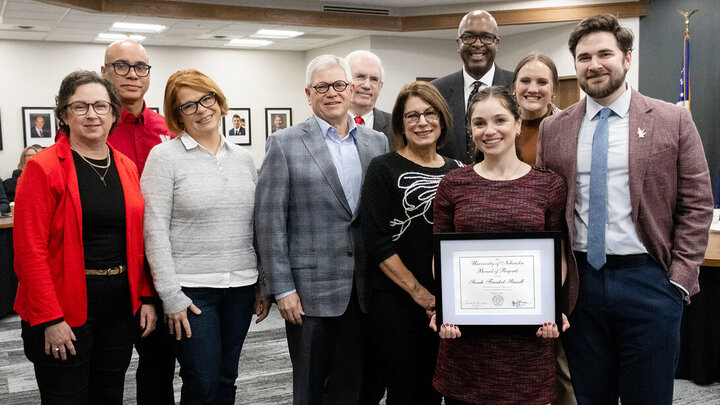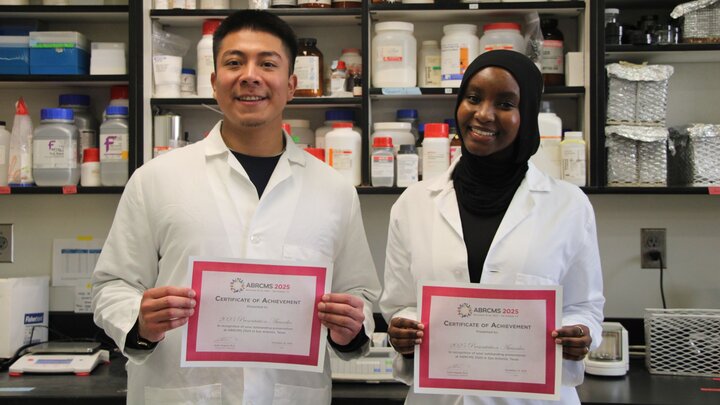David Harwood and Christopher Fielding, Earth and atmospheric sciences, and UNL colleagues coordinated research that extracted and examined a 3,375-foot-long rock sample from beneath Antarctica's McMurdo Sound. The drill core gave them a glimpse into Antarctica's climate between 20 million and 14 million years ago. Stories mentioning UNL's role in the research appeared in many outlets worldwide, including the Feb. 22 Washington Post, the New Zealand Herald, Voxy, and Science Daily.
Findings that male nursery-web spiders use their silks to immobilize females to avoid becoming victims of sexual cannibalism led to headlines about "kinky" spiders and "Fifty Shades of Gray" analogies. The research by Alissa Anderson and Eileen Hebets, biological sciences, appeared in LiveScience on Feb. 23. The Daily Express in the U.K., Island Crisis News in Mauritius,CNET, Tech Times and Death and Taxes magazine published reports over the next several days.
Daniel Brooks, a biologist affiliated with the H.W. Manter Laboratory of Parasitology was quoted by the Guardian in the U.K. in a Feb. 11 article about about the possibility that climate change has helped spread Zika virus.
Wheeler Winston Dixon, film studies, appeared in the Feb. 12 Toronto Star to discuss the rise of the "heroic villain" in movies like the recently released "Deadpool," which stars Ryan Reynolds. He said such characters resonate with a public that is disillusioned and disenfranchised.
Political psychology research led by Mike Dodd, psychology, and John Hibbing, political science, was cited in a Feb. 7 Daily Kos article about the role of biology in voters' support of conservative Republican candidates.
The Al Jazeera network presented a Feb. 16 panel discussion on the changing role of the International Red Cross. David Forsythe, political science, was among the experts discussing whether the Red Cross was losing legitimacy because it delegated to local organizations instead of operating directly in conflicts such as those in Syria and Yemen.
The Associated Press quoted Adam Houston, Earth and atmospheric sciences, and Matt Waite, journalism in a Feb. 25 report on a Nebraska legislative proposal to regulate drones. The two faculty members, whose research significantly features drones, were among those testifying to a legislative committee considering the measure. The AP story was carried by outlets nationwide.
Several science websites highlighted the development of metal-detecting biosensors by Rebecca Lai, chemistry. The story first appeared on Science Daily on Feb. 19. Science 360, the National Science Foundation's news service, highlighted Lai's research on Feb. 23. It was also featured on Nanowerk, Australian Mining, AZO Sensors and ChemEurope.
In a Baltimore Sun story about Faerie Magazine, Timothy Schaffert, English, discusses the universal appeal of fairy tales. Schaffert is an occasional contributor to the magazine, which is published in Baltimore.
Science Daily and other science-oriented websites reported that a research team led by Xiao Cheng Zeng, chemistry, had identified a new molecular form for ice. If it can be synthesized, it would be the 18th form of ice identified so far and the first discovered in the U.S. since before World War II. It also would be about 25 percent less dense than the record-low form synthesized by a European team in 2012. Stories began appearing on Feb. 12 and continued for several days in mid-February. The finding also was reported in Headlines and Global News, Cosmos, Science Alert, Red Orbit, Sci-News.com, the Daily Mail in the U.K., and Tech Times.



